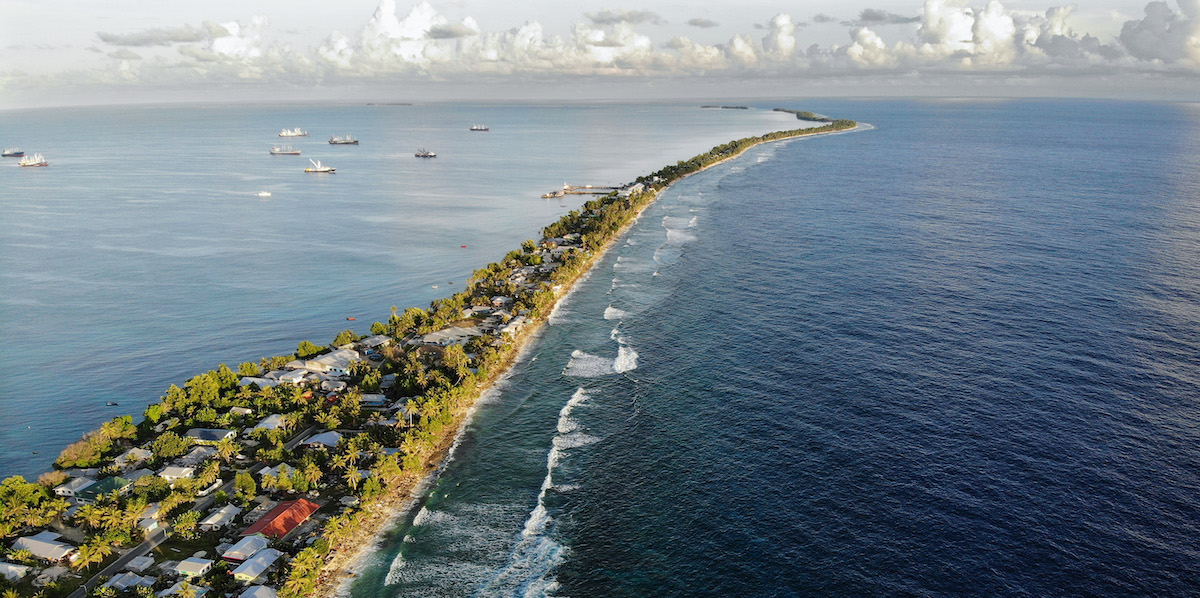Tuvalu is a Polynesian state in the Pacific Ocean made up of three coral islands and six atolls: with its total area of 26 square kilometres, it is the fourth smallest state in the world and, with about 12,000 inhabitants, the second least populated. As the crow flies, Tuvalu is halfway between Hawaii and Australia, it is also one of the nations in the world for which the effects of climate change are likely to be more catastrophic. Some of the atolls measure only twenty meters from coast to coast and the maximum altitude is just above sea level: the rise of the oceans linked to climate change is already causing erosion and loss of surface.
According to the projections based on current rate of sea rise, half of the lands of the capital Funafuti will be submerged by water within thirty years. Before the end of the century, 95 percent of the archipelago will be cyclically submerged by the tides, making it practically uninhabitable. Tuvalu is considered one of the first countries in the world at risk of definitive disappearance due to climate change.
For this reason in 2021 the Minister of Foreign Affairs, Justice and Communications Simon Tofe recorded his video in connection with the UN climate conference (COP26) in knee-deep water. The image had a moderate prominence in the world press, Tofe accompanied it with the slogan “We are sinking”.
Rising sea levels are one of the consequences of global warming caused by human greenhouse gas emissions: due to the increase in average temperatures in summer, the world‘s glaciers, and the ice covering areas such as Greenland, melt more than they can to refreeze. The progressive melting of the ice found on the emerged lands (therefore excluding the Arctic pack ice) causes the water in the oceans to increase and therefore raises sea levels. To this effect also adds up the thermal expansion of water: in fact, in addition to that of the atmosphere, the temperature of the oceans is also increasing and when the water warms up, the volume it occupies increases. As a result of these two phenomena combined, between 1900 and 2019 the mean sea level rose by 19 centimeters.
The first effects of the rising water level are already visible in Tuvalu and have forced the population and local administrators to make radical plans for the future. For some time there has been work to create a raised portion of territory, safe from the sea, but also to identify new territories where to relocate the population, while trying at the same time to keep the culture, traditions and history of the nation alive in some form.
Above all in the atoll of the capital already today the available surface is very limited: Funafuti develops along a road that runs through the atoll for its entire length. Houses, shops, public and religious buildings stand right on the roadside, in the little space that separates this from the beach: some houses have already been abandoned and along the coast it is easy to see debris, while the increase in sea level puts the supply of drinking water and food. Crops were already very limited, now even plants that bear edible fruit, such as the coconut palm and pulaka (taro), are at risk due to the presence of salt water.
A bird’s-eye view of Funafuti (Photo by Mario Tama/Getty Images)
Almost a fifth of the total population of Tuvalu has already emigrated, mostly to New Zealand, but negotiations have been opened with some states for a collective relocation that will allow the community not to lose its cultural roots: Australia has offered land, but only in exchange for maritime and fishing rights in the archipelago’s territorial waters: the government of Tuvalu refused.
Another project, called the Tuvalu Coastal Adaptation Project, was launched in 2017 in collaboration with the United Nations development program: it involves the construction of 3.6 square kilometers of elevated land, which will remain safe even when the expected elevation takes place sea level: this area should house schools, hospitals, commercial and residential areas. It is a long-term and very expensive project, for which the Tuvalu government is seeking foreign funds.
(Photo by Mario Tama/Getty Images)
The government is also working to guarantee the respect and legitimacy of the borders of its territorial waters even in the event of the disappearance of the islands, as well as the development of a “digital” island, which guarantees national coordination and the distribution of services to a population which will potentially be dispersed to various other states. Another project aims to create a digital copy of the current geography of the islands, using very high resolution images from satellites and drones. Tuvalu also wants to use the metaverse to create a shared space where citizens can interact and tell their stories and experiences, thus preserving the socio-cultural context of the country, even in the event that the islands are completely submerged and cease to exist.
– Read also: Land or sea?
